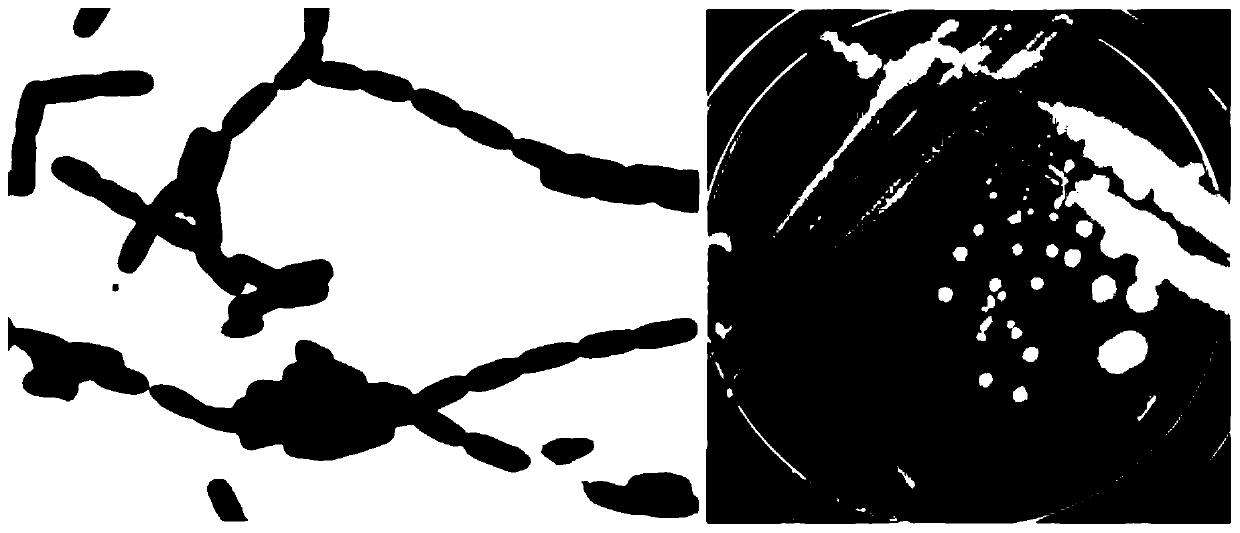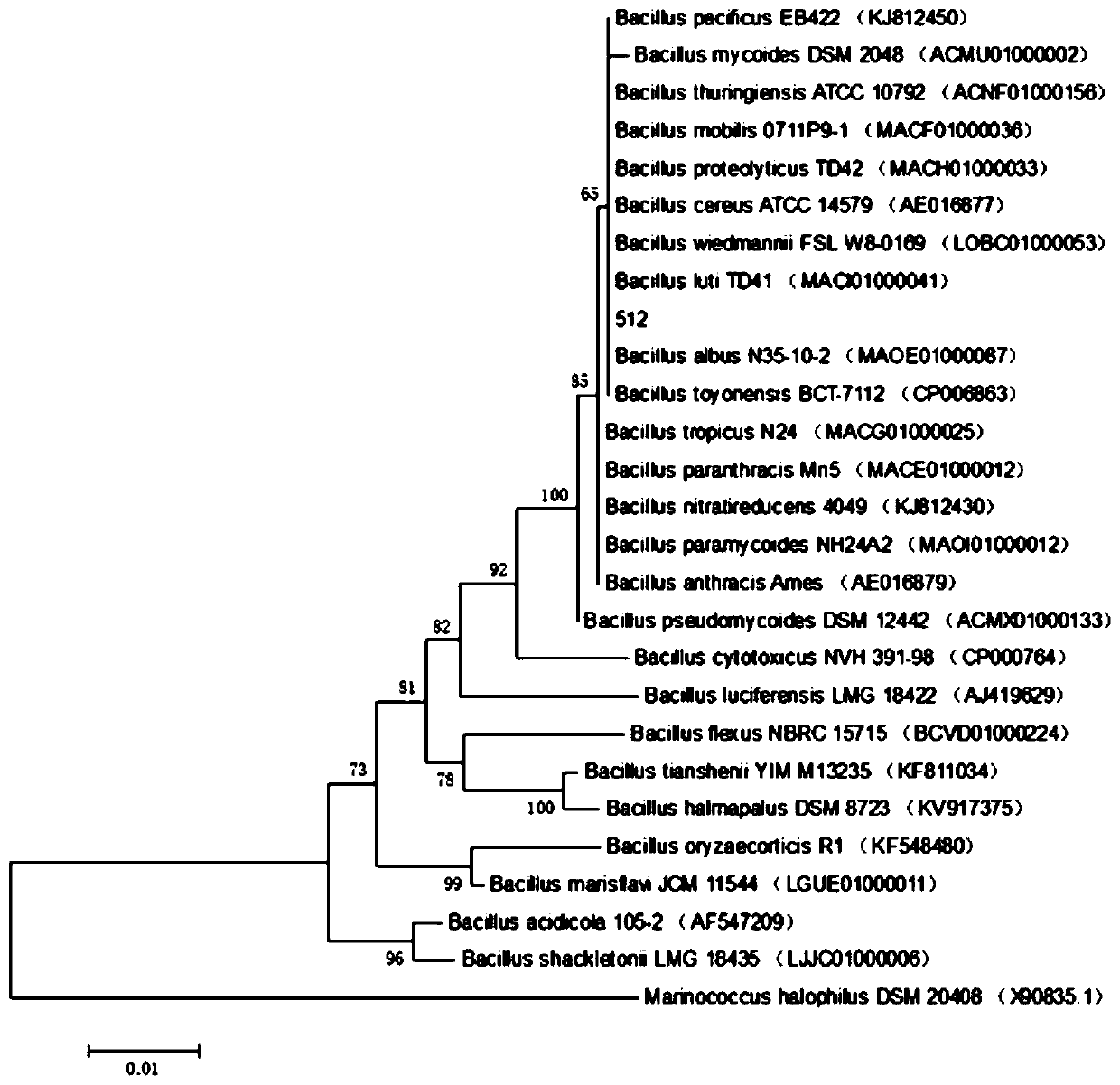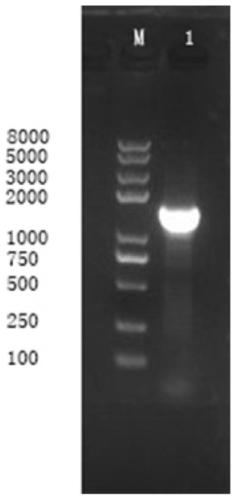Bacillus with antagonistic effect on rice bacterial blight and its isolation and application
A technology for bacillus and bacillus, which is applied in the field of bacillus cereus and its separation, and can solve problems such as increased drug resistance of pathogenic bacteria
- Summary
- Abstract
- Description
- Claims
- Application Information
AI Technical Summary
Problems solved by technology
Method used
Image
Examples
Embodiment 1
[0044] Embodiment 1: the acquisition of bacillus
[0045] 1. Soil source
[0046] Rhizosphere soil of Chinese cabbage in Sanming City, Fujian Province.
[0047] 2. Screening of bacterial strains
[0048] (1) Isolation of antagonistic bacteria
[0049] Plate dilution method: Weigh 10 g of the Chinese cabbage rhizosphere soil sample from Sanming City, Fujian Province into a sterile Erlenmeyer flask, add 90 mL of sterile water, shake in a shaker at 200 rpm and 28 ° C for 15 min, and then stand at room temperature for 5 min. Make soil bacteria suspension stock solution. Draw the supernatant of the stock solution of soil bacteria suspension in the centrifuge tube, carry out gradient dilution, obtain 10 0 、10 -1 、10 -2 、10 -3 、10 -4 A total of 5 gradients of bacterial suspension dilutions were taken, and 200 μL of each gradient was evenly spread on the NA plate containing the rice stripe bacillus RS105. Place the plate upside down in a constant temperature incubator at 28°C...
Embodiment 2
[0058] Example 2: Identification of Bacillus
[0059] 1.16S rRNA gene identification
[0060] Extract bacterial genomic DNA. Using the total DNA as a template, the 16S rRNA gene was amplified using specific primers 27F (5'-AGAGTTTGATCCTGGCTCAG-3') / 1492R (5'-TACGGCTACCTTGTTACGACTT-3'). The 50 μL reaction system used in this experiment is as follows:
[0061] Table 1 Taq polymerase chain reaction system
[0062]
[0063] The PCR reaction program was: pre-denaturation at 95°C for 3 min; denaturation at 95°C for 30 s, annealing at 56°C for 30 s, extension at 72°C for 90 s, 30 cycles; extension at 72°C for 8 min. After the reaction, the PCR products were checked by 1% agarose gel electrophoresis, and the gel imager was used to detect and record the results (see attached image 3 ). PCR products were sent to Bosun Biotechnology (Shanghai) Co., Ltd. for sequencing. According to the obtained 16S rRNA sequence (see sequence 1), Blast searched for homologous sequences in GenBan...
Embodiment 3
[0088] Embodiment 3. Bacteriostatic Spectrum Determination
[0089] Inoculate the pathogenic bacteria and the tested Bacillus into the NA liquid medium respectively, and culture them in a shaker at 28°C and 200rpm for 10-16h; draw 200 μL of each pathogenic bacteria and mix them well with the NA solid medium, and pour the plates; Place an Oxford cup with an outer diameter of about 8 mm in the center of the NA plate, add 15 μL of Bacillus suspension to the Oxford cup, and incubate in a biochemical incubator at 28°C for 48-96 hours. Repeat the experiment three times for each pathogen, observe and record the inhibition zone size, and calculate the rate of inhibition. Bacterial inhibition rate=(inhibition zone diameter-Oxford cup diameter) / inhibition zone diameter*100%.
[0090] The antagonistic effect of Bacillus 512 on 15 different rice leaf spot fungi (Xanthomonas oryzae pv.oryzicola, Xoc) Figure 6 shown.
[0091] The antagonistic effect of Bacillus 512 on 14 different Xanth...
PUM
 Login to View More
Login to View More Abstract
Description
Claims
Application Information
 Login to View More
Login to View More - R&D
- Intellectual Property
- Life Sciences
- Materials
- Tech Scout
- Unparalleled Data Quality
- Higher Quality Content
- 60% Fewer Hallucinations
Browse by: Latest US Patents, China's latest patents, Technical Efficacy Thesaurus, Application Domain, Technology Topic, Popular Technical Reports.
© 2025 PatSnap. All rights reserved.Legal|Privacy policy|Modern Slavery Act Transparency Statement|Sitemap|About US| Contact US: help@patsnap.com



